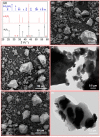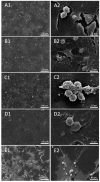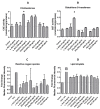Inflammatory, Oxidative Stress and Small Cellular Particle Response in HUVEC Induced by Debris from Endoprosthesis Processing
- PMID: 37176169
- PMCID: PMC10179554
- DOI: 10.3390/ma16093287
Inflammatory, Oxidative Stress and Small Cellular Particle Response in HUVEC Induced by Debris from Endoprosthesis Processing
Abstract
We studied inflammatory and oxidative stress-related parameters and cytotoxic response of human umbilical vein endothelial cells (HUVEC) to a 24 h treatment with milled particles simulating debris involved in sandblasting of orthopedic implants (OI). We used different abrasives (corundum-(Al2O3), used corundum retrieved from removed OI (u. Al2O3), and zirconia/silica composite (ZrO2/SiO2)). Morphological changes were observed by scanning electron microscopy (SEM). Concentration of Interleukins IL-6 and IL-1β and Tumor Necrosis Factor α (TNF)-α was assessed by enzyme-linked immunosorbent assay (ELISA). Activity of Cholinesterase (ChE) and Glutathione S-transferase (GST) was measured by spectrophotometry. Reactive oxygen species (ROS), lipid droplets (LD) and apoptosis were measured by flow cytometry (FCM). Detachment of the cells from glass and budding of the cell membrane did not differ in the treated and untreated control cells. Increased concentration of IL-1β and of IL-6 was found after treatment with all tested particle types, indicating inflammatory response of the treated cells. Increased ChE activity was found after treatment with u. Al2O3 and ZrO2/SiO2. Increased GST activity was found after treatment with ZrO2/SiO2. Increased LD quantity but not ROS quantity was found after treatment with u. Al2O3. No cytotoxicity was detected after treatment with u. Al2O3. The tested materials in concentrations added to in vitro cell lines were found non-toxic but bioactive and therefore prone to induce a response of the human body to OI.
Keywords: corundum; cytokines; endoprosthesis failure; lipid droplets; reactive oxygen species.
Conflict of interest statement
The authors declare no conflict of interest.
Figures






References
Grants and funding
LinkOut - more resources
Full Text Sources
Research Materials

